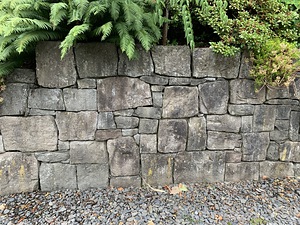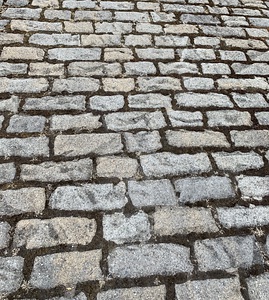
The ability to think critically, imaginatively and creatively is core to our humanity. Yet, the way we go about thinking differs. Divergent thinkers commonly use imaginative techniques while convergent thinkers depend on logic. Lateral thinkers use both convergent and divergent ways to solve problems.

Examining walls on my walk through Portland neighborhoods makes me think about the way we construct our lives. I spoke to a few home owners who confirmed my suspicion that their walls mimic their thought processes, and, though my study is flawed since my sample is too small, there may be some truth to what I saw. The walls remind me that we spend our years putting puzzles that together help us stand firm and strong. The pieces we pick up are of varying size with some hard with jagged edges while others are soft. They often are intertwined and get pulled apart to be reassembled according to the way our brains work.
As toddlers, we ascend steps to quarries filled with hard, solid pieces that were shaped through the ages. We approach with parents by our side holding our hands until we are old enough to carry a load out and assemble the pieces on our own. At first we step cautiously, not sure of what we will find or if we will be able to grasp and hold on to misshapen forms. We’re attracted to marble that sits shiny on top reflecting sunlight but notice vulcanized lava hiding below in dark, dreary crevices. It makes us afraid. We want to dig it out and throw it away.
When older, we are anxious yet excited to go by ourselves to gather the pieces we need for our puzzle. We start by following the path our parents set out for us, but when the time is right we begin to think on our own and start to gather, shape and build the puzzle as we want it to be.
Some of us cut the pieces in squares and rectangles, making neat edges so they can easily be piled on top of one another and arranged in ridged formations. Those a bit more venturesome try circles.
No matter, for our convergent thinking leads us to set each shape, size and color in a designated place that follows lists, goals, and maps we laid out in advance. As the puzzle comes together we examine it carefully and see to details to make sure nothing is out of place. Odd shaped pieces are chiseled until they fit correctly—comfortably.
When an unexpected piece suddenly appears to disturb the layout, we are upset until we find a way to put the pattern in order again. We tie them together with mortar so they won’t stray. Their rigid structure makes us feel secure. It defines what is write and good, not wrong and evil, and let’s us know how powerful we are, how perfect. It holds us and lets us stand atop its strong foundation.
Then there are those of us who don’t think in straight lines, but diverge to explore many possible solutions. Though we see the big picture, to get there we let our imagination go wild and select pieces randomly until patterns emerge. We view each heavy bolder and light pebble as unique and look for unusual ways to join them together so they’ll be sturdy enough to create a pleasing whole. Odd shaped holes are no bother for we know the puzzle will get filled in over time with the random chinks that we trip over as we walk. They are gems to be collected so that when their wisdom is revealed they give meaning and to our puzzle.
Some of us view what we do as organic for we blend hard objects of varying shapes and sizes and intermingle them with soft plowed earth and fragrant wild flowers. Though our divergent method may appear chaotic, it really fulfills the same goal as that held by convergent thinkers. Our random approach creates a beauty that differs, is all.
Many of us are hybrids who think outside the box—using a little of this and little of that. Our approach is indirect and creative, not immediately obvious and can’t be obtained by traditional step-by-step logic. By the time we are finished with our puzzle we’ve combined different shapes and sizes and made sure they fit tightly together.

Life’s task is to put our puzzle together so we can build a structure that will stand firm in the wind. Linear or convergent thinking uses logic, rules and rationality to solve problems. It is a thought process that follows known cycles or step by step progression. A response must be elicited before the next step is taken. Linear thinkers use a singular thought process leading toward completion while ignoring possibilities and alternatives. It is focused, sequential and methodical.
Divergent Thinking is used to generate creative ideas by exploring many possible solutions. It tends to be free flowing and spontaneous. After exploring many alternative ideas, unexpected connections are drawn that are used to satisfy goals.
Lateral thinking, first coined by Dr. Edward de Bono, solves problems by using both and indirect and creative approach. It likes between classic step-by-step problems solving and brainstorming. It uses reasoning that is not immediately obvious and often pursues ideas that are not obtainable. It is what is mean when asked to think outside the box. Lateral thinkers start with a known idea with the goal of creating new ideas. To do so they look for possibilities and alternative ways of solving problems. There may be starts and stops as they go down dead end paths before trying another approach. When an idea takes form it is usually plugged into linear plans.
The picture below is the wall to an 60 year old house that had several owners, three of whom added to the structure. It is interesting to surmise the thought processes the three used to built their lives.

References:
Teachthought Staff (2018) Three Modes of thinking: Lateral, Divergent & Convergent Thought. Teachthought. retrieved from https://www.teachthought.com/critical-thinking/3-modes-of-thought-divergent-convergent-thinking/
de Bono,E. . What is Lateral Thinking. Dr. Edward de Bono’s web site. retrieved from https://www.edwddebono.com/lateral-thinking
Team ZipRecruiter(2017) How Lateral Thinking Can Help Your Career. Columbus Dispatch. retrieved from https://www.dispatch.com/ZZ/news/20171117/how-lateral-thinking-can-help-your-career
Lluks, H. MD (2017)Vertical vs Lateral thinking in Healthcare. retrieved from https://www.howardluksmd.com/medical-social-media/vertical-vs-lateral-thinking-in-healthcare/
What type of thinker are you. Do comment on my blog below.
Sorry but Rock Creek Awakens is sold. To see other work go to eichingerfineart.com.





